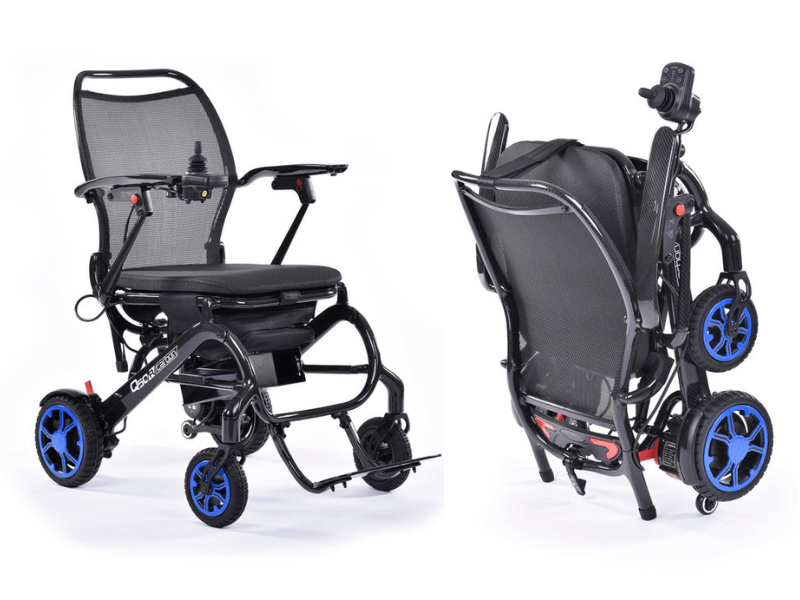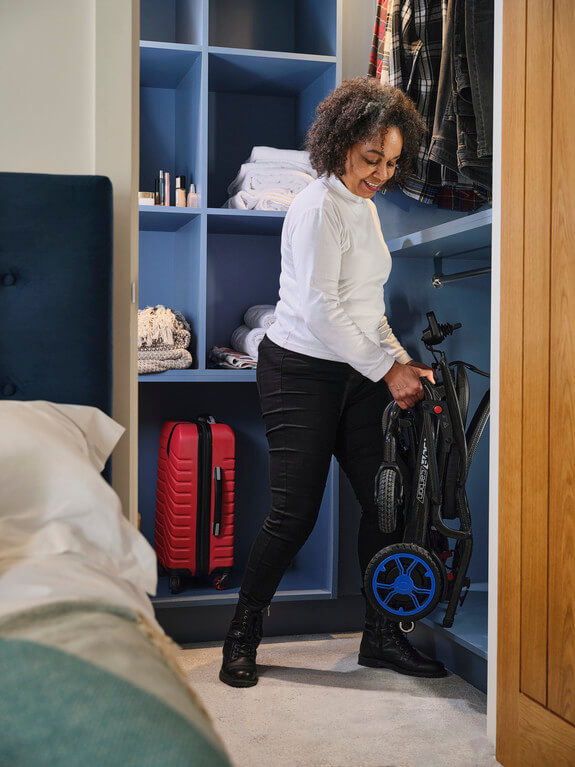Partagé:
Take it offline!
This Education in Motion resource is also available as a printable PDF.
Téléchargez PDF
Propelling a manual wheelchair is tough.
Whenever I’ve had occupational therapy students learning about wheelchairs and related assistive technology, I asked them to propel across the hospital campus to the canteen, buy an item and return. It was a distance of around ¼ mile over mostly level indoor surfaces, with a few ramps and moderately uneven pavements.
The students were all young females who had no mobility limitations. Although none of them had a dedicated workout routine to build upper limb strength, they also had no history of upper limb problems. We used an entry-level, lighter weight configurable folding chair style similar to those frequently provided on British NHS (National Health Service).
None of them made it all the way back to our clinic without being pushed.
Why use a folding powered wheelchair?
Whilst the configuration of a manual wheelchair makes a huge impact, as discussed in our blog on the role of weight in wheelchair optimisation, many people benefit from additional powered options to go everywhere they want in a day. Add-on power is one option. But these aren’t right for some people who need a mobility boost, such as individuals who:
- Walk (with or without an aid), but fatigue or have pain with long distances
- Use a wheelchair not compatible with add-on power, such as those with swing-away legrests
- Need to use a wheelchair part-time to help with indoor activities that require carrying objects. For example, many amputees who walk (and even run) with a prosthesis, but may have a break from use at home at times for pain management and skin health. A compact powered wheelchair can keep hands free for cooking and other home activities.
- Are engaging in a long recovery from injury, stroke, or extended illness and may need help with mobility for a couple of years but may not need powered mobility support long-term. It may not therefore be suitable to make major home environment or vehicle adaptations.
- Have fluctuating needs, such as people managing the effects of remitting/relapsing multiple sclerosis (1) long COVID (2, 3) or ME (chronic fatigue syndrome)(4).
In these situations, a folding powered wheelchair can be a practical tool. They can go into car boots, be folded for trains and are much more compact than a mobility scooter at home or in shops.
The challenge is that power chair frames are inherently heavy. They must be robust enough to withstand the forces associated with a powered mobility device, plus have the additional weight of batteries and motors. Folding is another consideration – the chair needs to remain fully secure when open but remain easy to manage, lift and store. This has inspired the latest innovation in powered chair folding technology: carbon fibre frames.
Carbon fibre chairs offer a solution for people who want to go farther, faster and save energy for the activities they enjoy. Lighter than their aluminium-frame counterparts, these go-anywhere chairs can fit into even a compact car and open a world of exploration. These are impressive bits of technology, but who are they best suited for?

Short to moderate periods of daily use
Carbon-fibre folding powered chairs are designed for up to a few hours at a time to complement other forms of mobility, like walking with an aid or manual wheelchair use. Use a rollator but need to have hands free for cooking? Want to attend a concert at an expo centre and worried about walking the corridors without pain? Use a manual chair, but want to part-time power to explore a nearby hilly city? These chairs can be a good option.
Yet, carbon-fibre folding chairs cannot accommodate the heavy components needed for powered seating functions like tilt, recline or lift. They are comfortable for up to a few hours at a time alongside other places to sit such as a sofa, desk chair or dining chair. The Q50R Carbon and similar designs also need to have small, light batteries. Using lithium-ion technology helps with capacity but still means the range is more limited than the large batteries found in non-folding powered wheelchairs.

Seating
Carbon-fibre material helps reduce vibration (5,6) that can otherwise exacerbate the pain of arthritis or other joint problems. However, they are designed for people who have intact sitting balance - the frame is not designed for fitting of prescriptive seating components. Whilst the Q50 R Carbon and other similar chairs can take up to 5cm thick flexible-base cushions, like the JAY Easy Visco, for extra comfort, they do not have the adjustability for thick pressure-reducing cushions.
Sizing
Carbon-framed folding powered chairs like the Q50R Carbon prioritise lightness, requiring the design to shed heavy hardware needed for high levels of adjustability. Therefore, they come in effectively one size that fits many, but not all. Like most chairs of this type, the Q50R Carbon accommodates people with hip widths of up to approximately 46 cm across. Other options, such as powered wheelchairs that have folding backs like the Q200 R can provide an alternative with a larger size range, but will need a boot hoist for lifting.
Carbon folding frame powered wheelchairs have a pre-set balance point, so this device suits people of a relatively ‘typical’ weight distribution within their body. Those with a very forward personal centre of mass (e.g. extreme chronic lower limb oedema) or very rear personal centre of mass (e.g. bilateral above knee lower limb amputees who are not wearing prostheses) may have difficulties with performance. More stable outdoor-minded folding models like the aluminium Q50 R are an option to consider, or a more traditional scooter or powered wheelchair may be needed.
When matched mindfully to the client, carbon fibre folding powered wheelchairs can offer a practical mobility solution for active lifestyles.